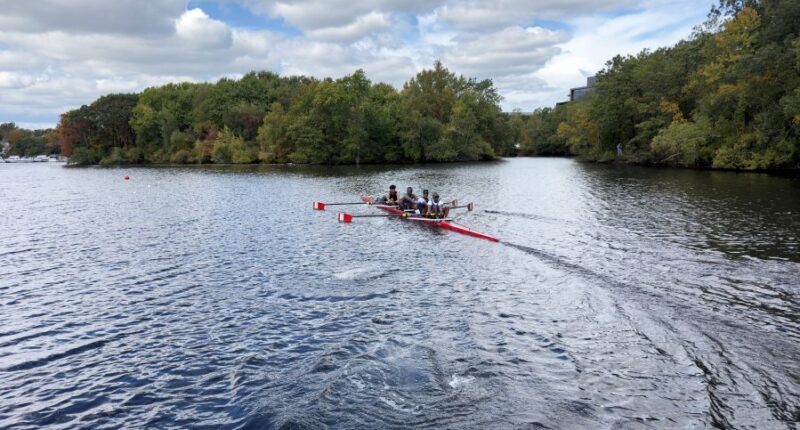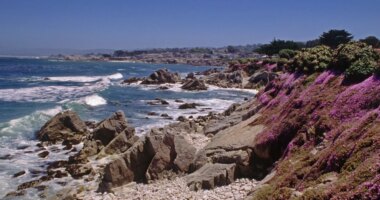Share this @internewscast.com

BOSTON (AP) — In a groundbreaking moment, a group of four rowers from South Africa are set to make history at the Head of the Charles Regatta in Boston this weekend. They will be the first team of color from their nation to compete on an international stage.
Their involvement signifies a global initiative to democratize a sport that has long been dominated by white athletes, aiming to usher in a more inclusive era for the 60-year-old regatta and the sport as a whole.
The roots of competitive rowing trace back to English colonists in both South Africa and the present-day United States, who historically restricted access to the sport, barring large segments of local populations from participating in aquatic recreation.
Recently, a collective of advocates has worked to bring together athletes from various backgrounds, resulting in several historic firsts at the Charles. These milestones include the debut of the first all-Black women’s 8+ from the U.S., an indigenous 4+, and a native women’s 4+, among others. In rowing terms, an 8+ refers to an eight-person sweep boat with a coxswain to guide, while a 4+ is a similar setup with four rowers and a coxswain.
Lwazi-Tsebo Zwane, a 23-year-old athlete training in Germiston, South Africa, near Johannesburg, acknowledges the significance of their role as pioneers for aspiring young rowers.
“Reaching this regatta has required overcoming numerous challenges,” remarked Zwane, who will participate in the Men’s Championship 4+ event. “There have been many obstacles and hurdles to navigate.”
Wearing the colors of Western Cape Rowing, Zwane said the legacy of poverty and economic inequality that were the result of racist policies like apartheid in South Africa and others leveraged in the U.S. “have shaped and narrated our story to be one of violence and oppression and being second rate.”
“There is a different story for us, but doing the work to get there is not an easy feat,” he said of reframing the false narratives.
Lack of access, not lack of talent
Rowers who aren’t white or from affluent backgrounds in America and South Africa face many of the same issues, said Arshay Cooper, whose foundation worked to bring the South African crew to the Charles, as well as crews of underrepresented athletes from the U.S.
Among those issues: lack of access to waterways and to skills like swimming and the cost of buying and storing equipment. Rowing shells alone cost tens of thousands of dollars.
“There’s structural limitations, there’s neglect,” said Cooper, who joined America’s first all-Black high school rowing team in Chicago in 1997. “There’s talent everywhere, but not a lot of access and opportunity.”
In both countries, some public schools — where athletes of color are more likely to attend — offer access to some type of rowing program. But the equipment is older and the coaches more novice, making it hard to compete with private schools with more resources.
Modern competitive rowing emerged in the 19th century at British schools like Oxford and Cambridge and expanded to elite American colleges, like Harvard, Yale and Princeton — institutions that excluded those who were from working-class backgrounds and not white or male.
A 2016 analysis by U.S. Rowing found the typical rower is often perceived as “white and come from a middle or upper class suburban community”. A 2021 study on gender and race in sports by the NCAA found that among female collegiate rowers, just 2% identified as Black, while 5% identified as Hispanic and 3% identified as Asian. The sport ranked among the bottom third least diverse sports of the 45 that the NCAA polled.
“For most people of color, they’re the only person of color in the boat,” said Denise Aquino, a Filipino American and co-founder of the nonprofit podcast Rowing in Color, which organized the Head of the Charles’ first all-Black women’s 8+ in 2022.
Cooper said the goal is to add new faces to the sport. Sometimes those new faces are using the platform to highlight social issues. Last year, the regatta’s first-ever indigenous four raced down the course with red hands painted on their oars and faces to honor murdered and missing indigenous women.
Aquino said she said she and her team felt an added layer of urgency this year because of recent policies from the U.S. White House limiting government diversity, equity and inclusion initiatives.
“We’re definitely feeling that sense of fear, but also we’re going to do it anyway,” she said. “It’s about the young people and people of all ages who will see these boats and feel not just resonance, but feel visibility and represented in the sport that we all love.”
Connecting to the water in South Africa
Coach Michael Ortlepp said many of the university athletes he usually coaches in the southwestern coastal city of Cape Town make considerable sacrifices to even get to the boathouse for practice. Most live inland in formerly segregated townships where public transportation isn’t reliable. A few have struggled to find housing at all. Some mornings, he gets messages from rowers saying they can’t attend practice because of gang warnings in their neighborhoods and shootings. Part of the funding from Cooper’s foundation has helped to pay for a bus to collect athletes for practice.
With Cooper’s support, Ortlepp’s Association has grown from eight rowers to 45 in three years.
“I’ve had rowers living in cafeterias for a week at a time without food or any kind of accommodation. Those are common stories; they’re not rare,” Ortlepp said.
Zwane, who first began rowing at age 14, said he takes several mini buses a day to get to Victoria Lake, near Johannesburg.
The community rowing boathouse where he is preparing for the race in Boston, one of many boathouses dotting the shores of the Charles River, is a far cry from the facilities he is used to.
“It does feel a little bit disorientating to be in this environment because this is everyone’s day-to-day, just normal life. This is — from my perspective, from a lot of kids who understand how it is to grow up from my place — it’s a luxury. If anything, it’s a once-in-a-lifetime experience,” he said. “Every day I get on the water, every day we leave here, every day we see different sights. … It is always on the back of my head that this is not normal for me, but it is for somebody else.”
“I think we’re more fortunate to have the ability to get closer to these spaces, but getting to those spaces has become harder than anything.”
















